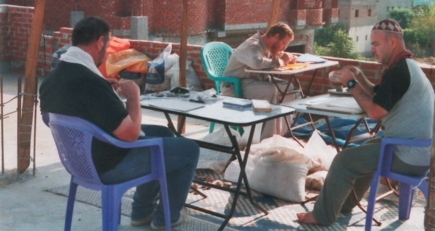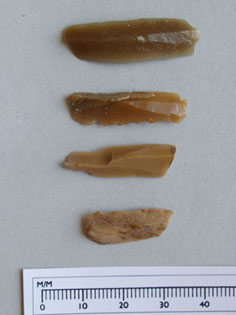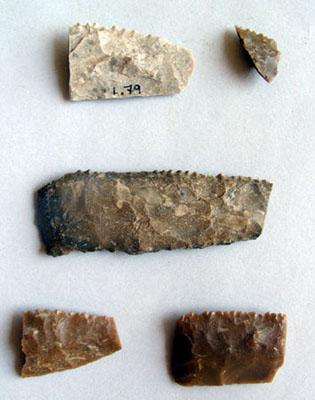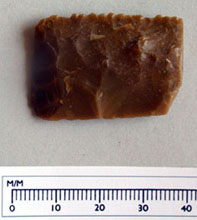Saïs Report, 2006
Season Reports
Saïs Report, 2006
Introduction
The Durham University/Egypt Exploration Society Mission was in the field from19th March to 20th April and between 15th August and 24th September 2006. It comprised: Penelope Wilson (Field Director), Dimitris Grigoropoulos (Roman Ceramicist), Salima Ikram (Animal Bones), Lauren Woodard, Janine Fisher, Gregory Gilbert, Geoffrey Tassie, William Cooney, Karen Exell (Illustrators), Edward Cork (GPS and Magnetometer Surveyor), Sophie Whitaker (Arabist), Alan Clapham (Archaeobotanist), Mahmoud Ali Abdel Rahman and Gamal Salim Ahmed Ali (SCA Representatives). In addition, the mission was assisted by Inspectors Said Ibrahim el-Assal, Emad Mohamed El Shenawy, Mohammed Abd el Aziz, Ibrahim Desuqi and Inspectors Abdel Mounsef el Khalil and Yasser Nada from Samanoud. Thanks are due to Rawya Ismail and Faten Saleh in the EES Office in Cairo, Fatma Rageb Kamal and Said Mutawally in Tanta and Fawzy Fawzy el Kholy in Damanhur.

The Sais (Sa el-Hagar) Project is now in its post-excavation and recording phase. The teams are working on the documentation and analysis of the pottery, small finds, animal bones and environmental samples from the excavations carried out as part of the ‘Sais and its Hinterland’ Project, funded by the Arts and Humanities Research Council of the United Kingdom.
Kom Rebwa (Sa el-Hagar): Final Excavation Report : The Ramesside Period
The drawing and photography of objects (small finds) from Excavation 1 was completed in order to prepare the publication of material for the Final Report. In addition, most of the significant pottery from Excavation 1 was studied, reconstructed (if necessary) and drawn in preparation for the establishment of a typology and corpus for the site to be published in the Final Report.
The bulk of the material dates to the Ramesside Period and is most immediately comparable to the published corpus from Qantir. The archaeological results suggest that there were at least two distinct Ramesside phases and indications of earlier settlements material in lower strata, possibly from Dynasty 18 and the Old Kingdom. The correlation of the archaeological matrix and the pottery typology, as well as further study and comparison with other sites will be used to evaluate the nature of Ramesside interest at Sais and the kinds of settlements there. The impression from the material is that the excavation found a late Ramesside farmhouse with an impressive front room and side chambers. It was well supplied with imported wine from Canaan and Syria, as well as having impressive storage facilities for processed meat and other foods. A few finewares and amulets suggested that the people here were comparatively well-off, perhaps local officials managing royal or temple estates. The presence of many fragments of pottery cobra figures suggests that there was a well developed household cult of a protective snake goddess at Sais, in common with many similar locations in Egypt and in the western Delta, for example at Kom Firin and Tell Abqa’in. The material suggests that ‘Ramesside’ culture had a relatively homogenous appearance over the whole of the Delta and that the state was running its estates successfully.
The earlier Ramesside site was much more industrial in scale with banks of ovens for cooking bread, kilns for pottery or cooking and storage bins for grain. The cone-like bread moulds may suggest that this was specifically a temple foundation, producing bread for offering in the temple. The archaeobotanical information is also providing rich evidence for the floral material at the Ramesside site. A sample from context [1094], the early Ramesside layer, was analysed and found to contain beet-root seeds, olive and grape stones as well as barley and emmer –wheat and marshland plants, such as mallow. The earlier strata attest to the continued settlement of an area of high ground, a sand hill, over a long period of time. The presence of distinctive ‘Medum’ ware basins and bowls dating to the end of the Old Kingdom suggest that there is an Old Kingdom settlement buried under Kom Rebwa. In common with sites such as Mendes, it is possible to trace continued State management of this key site. Once the nome capitals were established they seem to have been the first line of communication of the central government for the management of the colonies in the delta and their estates.
The Prehistoric Period at Sais (Sa el-Hagar): Final Excavation Report
All of the pottery from the Prehistoric phases of Excavation 8 was drawn and analysed for publication in the Final Report. The flint lithic tools were a focus of the work in the summer and they provide a useful corpus of material showing the changes in the flint tool-kit from the Early to Late Neolithic Period.
 | Flints. |
The mass of small bladelets and cutting edges produced in the early phase are replaced by fewer blades and more bifacial cutting knives, arrowheads and sickle stones in the Later Neolithic Period. This may be related to the increasing sedentary existence of people in Egypt, who relied more on the cultivation of grains than upon the husbandry of pigs and harvesting of the natural fish resources of the Nile and its flooded pools. In broad terms we can show the change from meat processing and a meat-elite with its sharp bladed tool-kit, to the broader based society with bread making and grain processing as its main form of nutrition.processing and a meat-elite with its sharp bladed tool-kit, to the broader based society with bread making and grain processing as its main form of nutrition.
The study of the stone tools has also provided good examples of Late Neolithic hand-axes as well as a corpus of pounders and burnishing stones.
 |  Above : Sickle stone blade detail. Left and below : Sickle stone blades. |

Sais seems to have provided a focal point of settlement for people into the Buto-Maadi Period, when more substantial mud structures were built at the site. The animal bone record also shows the predominance of pigs as the meat of choice for Prehistoric period people. The animals must have been relatively easy to rear in the marshy conditions implied by the floral record which also contained evidence for einkorn wheat, and flax as well as barley and emmer-wheat. The comparative material from Merimde Beni Salame and the Fayum should provide a broader dataset for understanding the Neolithic transitions by placing this, the only Neolithic site in Egypt excavated on the flood plain into the broader context of the arrival of domestication into Egypt from the Near East and the network of contacts and sites such as those in the Fayum and at Merimde Beni Salame. The material at Sais demonstrates the potential for developing the data-set of Neolithic evidence into a larger statistical and settlement based study.
